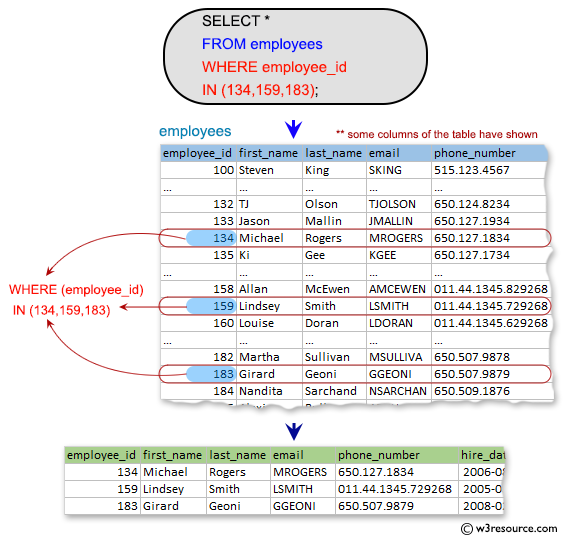SQL Exercises: Employee whose id is any of the number 134, 159, 183
From the following table, write a SQL query to find those employees whose ID matches any of the numbers 134, 159 and 183. Return all the fields.
Sample table: employees
+-------------+-------------+-------------+----------+--------------------+------------+------------+----------+----------------+------------+---------------+ | EMPLOYEE_ID | FIRST_NAME | LAST_NAME | EMAIL | PHONE_NUMBER | HIRE_DATE | JOB_ID | SALARY | COMMISSION_PCT | MANAGER_ID | DEPARTMENT_ID | +-------------+-------------+-------------+----------+--------------------+------------+------------+----------+----------------+------------+---------------+ | 100 | Steven | King | SKING | 515.123.4567 | 2003-06-17 | AD_PRES | 24000.00 | 0.00 | 0 | 90 | | 101 | Neena | Kochhar | NKOCHHAR | 515.123.4568 | 2005-09-21 | AD_VP | 17000.00 | 0.00 | 100 | 90 | | 102 | Lex | De Haan | LDEHAAN | 515.123.4569 | 2001-01-13 | AD_VP | 17000.00 | 0.00 | 100 | 90 | | 103 | Alexander | Hunold | AHUNOLD | 590.423.4567 | 2006-01-03 | IT_PROG | 9000.00 | 0.00 | 102 | 60 | | 104 | Bruce | Ernst | BERNST | 590.423.4568 | 2007-05-21 | IT_PROG | 6000.00 | 0.00 | 103 | 60 | | 105 | David | Austin | DAUSTIN | 590.423.4569 | 2005-06-25 | IT_PROG | 4800.00 | 0.00 | 103 | 60 | | 106 | Valli | Pataballa | VPATABAL | 590.423.4560 | 2006-02-05 | IT_PROG | 4800.00 | 0.00 | 103 | 60 | | 107 | Diana | Lorentz | DLORENTZ | 590.423.5567 | 2007-02-07 | IT_PROG | 4200.00 | 0.00 | 103 | 60 | | 108 | Nancy | Greenberg | NGREENBE | 515.124.4569 | 2002-08-17 | FI_MGR | 12008.00 | 0.00 | 101 | 100 | | 109 | Daniel | Faviet | DFAVIET | 515.124.4169 | 2002-08-16 | FI_ACCOUNT | 9000.00 | 0.00 | 108 | 100 | | 110 | John | Chen | JCHEN | 515.124.4269 | 2005-09-28 | FI_ACCOUNT | 8200.00 | 0.00 | 108 | 100 | .................... +-------------+-------------+-------------+----------+--------------------+------------+------------+----------+----------------+------------+---------------+
Sample Solution:
-- Selecting all columns (*) from the 'employees' table
SELECT *
-- Filtering rows based on the condition that the 'employee_id' is in the specified list (134, 159, 183)
FROM employees
-- List of specific 'employee_id' values to filter the result set
WHERE employee_id IN (134, 159, 183);
Sample Output:
employee_id first_name last_name email phone_number hire_date job_id salary commission_pct manager_id department_id 134 Michael Rogers MROGERS 650.127.1834 2006-08-26 ST_CLERK 2900.00 0.00 122 50 159 Lindsey Smith LSMITH 011.44.1345.729268 2005-03-10 SA_REP 8000.00 0.30 146 80 183 Girard Geoni GGEONI 650.507.9879 2008-02-03 SH_CLERK 2800.00 0.00 120 50
Code Explanation:
The said query in SQL that used to select all columns (indicated by *) from the employees table where the employee_id column is equal to any of the values in the list (134,159,183). The result of this query would be all the rows from the employees table where the employee_id column has a value of 134, 159, or 183.
Relational Algebra Expression:
Relational Algebra Tree:
Visual Presentation:
Alternative Statements:
Using OR Operator:
SELECT *
FROM employees
WHERE employee_id = 134 OR employee_id = 159 OR employee_id = 183;
Using IN Subquery:
SELECT *
FROM employees
WHERE employee_id IN (134, 159, 183);
Using UNION ALL:
SELECT * FROM employees WHERE employee_id = 134
UNION ALL
SELECT * FROM employees WHERE employee_id = 159
UNION ALL
SELECT * FROM employees WHERE employee_id = 183;
Go to:
PREV : Salary and reporting person id is 3000 and 121.
NEXT : Employees whose salary is within the given range.
Practice Online
Query Visualization:
Duration:
Rows:
Cost:
Contribute your code and comments through Disqus.
What is the difficulty level of this exercise?
Test your Programming skills with w3resource's quiz.





